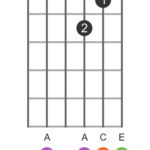Frank Zappa, a name synonymous with musical innovation and unparalleled guitar eccentricity, remains an enduring icon for musicians worldwide. His подхода to guitar playing and sonic exploration was as unique as his compositions, and a crucial element of his signature sound lay in his meticulously customized instruments and amplifiers. To celebrate Zappa’s legacy, we delve into some of his most iconic gear, guided by insights from his son, Dweezil Zappa, who has dedicated himself to preserving and showcasing his father’s musical heritage.
Dweezil Zappa, a formidable guitarist in his own right, offers a crucial perspective on understanding his father’s distinctive guitar tones. “Considering Frank rarely used anything stock, it’s difficult to ape his tones,” Dweezil explains, highlighting the challenge in replicating Frank’s sound due to his constant modifications and personalized setups. Dweezil, in his Zappa Plays Zappa tours, strives to honor his father’s sonic legacy, emphasizing, “For the most part, it’s really about having the right midrange, and being able to get controllable feedback at will.” This pursuit of controllable feedback and a distinctive midrange was central to Frank Zappa’s guitar sound, leading him to devise ingenious modifications.
One of Zappa’s key innovations was integrating onboard preamps into his guitars. These preamps granted him drastic EQ control directly at his fingertips and delivered a significant boost – up to a staggering 18dB. This level of control allowed him to shape his tone in real-time and achieve the desired feedback characteristics that were integral to his playing style. As Dweezil aptly puts it, “Frank really loved screwing around with stuff, and making it work for him and the way he played.” This spirit of experimentation and customization is evident in the impressive collection of guitars and amps that Frank Zappa amassed throughout his career. Thanks to Dweezil, we gain access to explore some of these remarkable instruments, offering a glimpse into the mind of a true sonic pioneer.
The Pignose Amp: The Secret Weapon of the ’70s
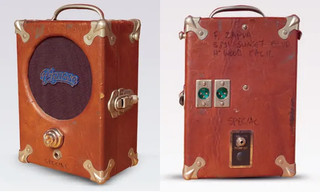
The unassuming Pignose amplifier holds a significant place in Frank Zappa’s gear history. This compact amp was instrumental in crafting the raw and edgy guitar tones heard on seminal albums such as Apostrophe(’) and Over-Nite Sensation. Despite its modest size, the Pignose became a workhorse in Zappa’s studio arsenal, favored for its distinct gritty character.
This particular Pignose amp, however, was not spared from Zappa’s penchant for modification. Evidence of his tinkering is visible in the two XLR jacks discreetly added to the back panel. These modifications likely catered to Zappa’s specific signal routing needs and his relentless pursuit of sonic manipulation. The Pignose amp’s portability and unique sound made it a favorite for live performances as well. In a memorable 1976 appearance on The Mike Douglas Show, Zappa was seen casually strolling onstage with this Pignose in one hand and his iconic “Baby Snakes” SG in the other, ready to unleash his sonic mayhem.
“Baby Snakes” Gibson SG: A Custom Creation
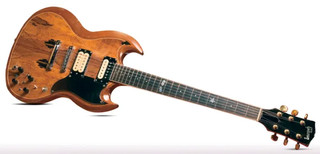
The “Baby Snakes” SG occupies a special place as Frank Zappa’s primary guitar during the latter part of the 1970s. Interestingly, this guitar is not a standard Gibson model but rather a bespoke creation from an anonymous luthier in Phoenix. As the story goes, this craftsman managed to get backstage and sold the instrument to Zappa for a mere $500.
While the guitar’s overall feel is reminiscent of a Gibson SG, closer inspection reveals unique, non-Gibson features. These include an unusual 23rd fret and distinctive inlays and ornamental woodwork, setting it apart from factory-produced models. Adding to its unique character, renowned luthier and electronics wizard Rex Bogue further enhanced the “Baby Snakes” SG. Bogue, known for his work restoring Jimi Hendrix’s charred Stratocaster, incorporated various modifications for Zappa, including phase switches and, crucially, an onboard preamp. Rex Bogue’s contributions solidified the “Baby Snakes” SG as a truly unique and sonically versatile instrument in Frank Zappa’s hands.
Mid-Seventies 100-watt Marshall JMP: A British Powerhouse
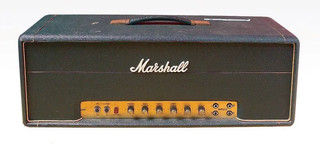
For sheer power and classic rock tone, Frank Zappa relied on the iconic Marshall JMP. This stock, mid-Seventies 100-watt Marshall JMP head became a central component of Zappa’s stage and studio rig from 1974 through his tours spanning 1979-84. Its reliability and raw power made it an essential element in delivering Zappa’s demanding and dynamic guitar performances.
Unlike many of his other pieces of gear, this Marshall JMP remained largely unmodified, attesting to its already potent sonic capabilities. Zappa appreciated the JMP’s straightforward design and its ability to deliver a powerful, unadulterated rock sound. This amplifier served as a robust foundation for Zappa’s effects and guitar modifications, allowing him to sculpt his signature tones with a powerful and responsive amp as his base. The Marshall JMP’s presence in Zappa’s setup underscores his appreciation for both classic rock power and his own innovative sonic explorations.
Gibson ES-5 Switchmaster: Vintage Roots
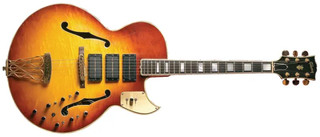
Venturing into the realm of vintage jazz boxes, Frank Zappa utilized a Gibson ES-5 Switchmaster during the formative years of his career. This ES-5 Switchmaster was employed extensively on the first three Mothers of Invention records, contributing to the band’s pioneering and eclectic sound. Notably, for the groundbreaking album Freak Out!, Zappa paired this guitar with a Fender Deluxe amp, creating a unique sonic blend that defined early Mothers’ recordings.
Despite its traditional jazz guitar origins, Zappa, in his characteristic style, couldn’t resist modifying the ES-5 Switchmaster. This “portly, knob-festooned jazz box” was later equipped with Barcus Berry pickups and an array of additional switches and knobs. However, according to Dweezil, these later modifications are no longer functional, leaving the guitar in a state of intriguing electronic mystery. The Gibson ES-5 Switchmaster represents Zappa’s early explorations in tone and his willingness to push the boundaries of even classic instruments.
Gibson Les Paul Custom: Stage and Studio Staple
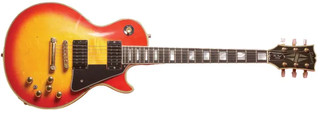
Immortalized on the cover of Shut Up ’n Play Yer Guitar, this Gibson Les Paul Custom became a highly recognizable instrument in Frank Zappa’s guitar collection. This Les Paul Custom is loaded with powerful Seymour Duncan humbucker pickups, providing a thick and articulate tone that suited Zappa’s diverse playing styles. True to form, Zappa further customized this guitar with a Dan Armstrong Green Ringer circuit installed within the control cavity and an XLR output jack for direct injection.
Beyond the standard controls, an extra knob was added, functioning as a nine-position rotary switch. This switch offered a wide range of tonal options, including single-coil and humbucker configurations, as well as out-of-phase settings for even more sonic textures. A mini-toggle switch further expanded the tonal palette by selecting between series and parallel pickup operation. This heavily modified Les Paul Custom exemplifies Zappa’s commitment to sonic versatility and his desire to have complete control over his guitar’s sound.
“Roxy” SG: Evolved for Sonic Extremes
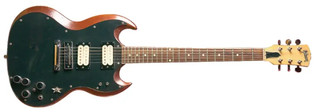
The “Roxy” SG is inextricably linked to the iconic 1974 album Roxy & Elsewhere, gracing the album’s cover and featuring prominently in performances from that era. Even in its “Roxy” days, this SG already sported two non-stock switches on its lower horn, hinting at Zappa’s early modifications. However, the guitar’s evolution didn’t stop there.
In the years following the Roxy period, this SG underwent further transformations. It was adorned with a striking mirrored top and received a suite of internal modifications, including additional preamps, phasing switches, and active-filter circuits. These augmentations demonstrate Zappa’s continuous pursuit of sonic innovation and his willingness to push his instruments to their absolute limits. The “Roxy” SG, in its final form, stands as a testament to Zappa’s relentless experimentation and his ever-evolving quest for unique guitar tones.
Martin D-18S 12-fret “Standard” Dreadnought: Acoustic Interludes

While primarily known for his electric guitar work, Frank Zappa also appreciated the nuances of acoustic instruments. This Martin D-18S 12-fret “standard” Dreadnought acoustic guitar represents his foray into the acoustic realm. Identified with the assistance of Martin Guitars’ Dick Boak, this model features a slotted headstock, a Brazilian rosewood fretboard, headplate, and bridge, complemented by mahogany back and sides, indicative of high-quality craftsmanship and rich tonal characteristics.
This Martin D-18S was specifically used in the 1974 recording of “Sleep Dirt” and the track “Blessed Relief” from The Grand Wazoo, showcasing its warm and resonant acoustic properties within Zappa’s diverse musical landscape. Interestingly, Zappa acquired this Martin by trading a Telecaster to its previous owner, Mark Volman (a.k.a “Flo”) of Zappa’s early Seventies “Flo and Eddie” lineup. This anecdote highlights Zappa’s discerning ear and his willingness to acquire instruments that would expand his sonic palette, even through unconventional trades.
Performance Guitar: High-Tech Tone Shaping
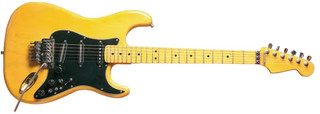
Used during Frank Zappa’s final tour in 1988, this custom-made Performance solidbody guitar represents the pinnacle of his tone-tweaking philosophy. This instrument is equipped with concentric knobs and tiny screwdriver-adjustable trimpots, reflecting Zappa’s deep dive into parametric equalization and his relentless pursuit of sonic perfection. These intricate controls allowed for extremely precise tone adjustments, embodying Zappa’s meticulous approach to sound.
Zappa’s guitar tech, Midget Sloatman, provided valuable insight into the function of these trimpots in a 1995 interview with GP. “The trimpots are identical parametric filter circuits,” Sloatman explained. “One trimpot is dedicated to bass frequencies from about 50Hz to 2kHz, and the other one affects the top-end frequencies from about 500Hz up to 20kHz.” These filters also featured a variable resonant frequency or ‘Q’ knob, granting Zappa unprecedented control over feedback. Sloatman elaborated, “He could basically tune his guitar to the room, determine how the room responded to the amplifier, and then use the Q control to elicit the feedback he wanted.” Furthermore, Zappa utilized these active filters to enhance high frequencies, bringing out subtle nuances in his string attack. The Performance Guitar encapsulates Zappa’s advanced understanding of sound and his commitment to pushing the boundaries of guitar technology.
Jimi Hendrix Sunburst Fender Stratocaster: A Legend’s Relic

Perhaps one of the most historically significant guitars in Frank Zappa’s possession was a sunburst Fender Stratocaster with a remarkable backstory. This Stratocaster was gifted to Zappa by a roadie of Jimi Hendrix and bore the scars of Hendrix’s legendary performance at the 1968 Miami Pop Festival, where it was famously “mutilated.” For years, this damaged piece of rock history hung on the wall in Zappa’s basement, a silent testament to a pivotal moment in music history.
Eventually, Zappa entrusted Rex Bogue with the task of restoring this iconic Stratocaster. In true Zappa fashion, the restoration involved not just repair but also further modifications. Bogue incorporated a Dan Armstrong Green Ringer and a Barcus-Berry contact pickup, embedding them within a replacement neck. While the neck and tortoise-shell pickguard are newer additions, the guitar retains its aura as a relic of both Hendrix’s fiery artistry and Zappa’s innovative spirit. Dweezil Zappa himself showcases this guitar and recounts its fascinating history in a video provided by Norman’s Rare Guitars, further cementing its legendary status.
Conclusion:
Frank Zappa’s approach to guitar gear was as unconventional and innovative as his music. His relentless experimentation with modifications, onboard electronics, and a diverse range of instruments solidified his signature sound and cemented his legacy as a true guitar innovator. From customized SGs and Les Pauls to modified amps and even a Hendrix relic, Zappa’s guitar arsenal reflects his boundless creativity and his unwavering commitment to pushing the sonic boundaries of the instrument. His meticulous approach to tone and his willingness to personalize every aspect of his gear serve as an enduring inspiration for guitarists seeking to forge their own unique sonic identities.

